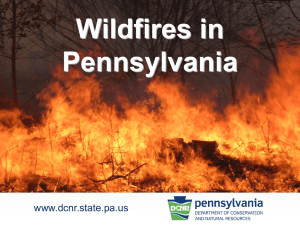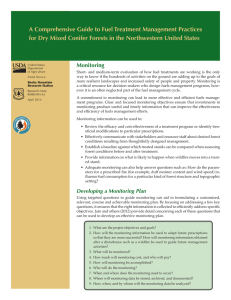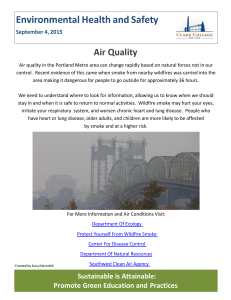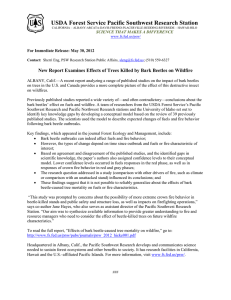In my mind, fuels treatments have long mattered, and I
advertisement
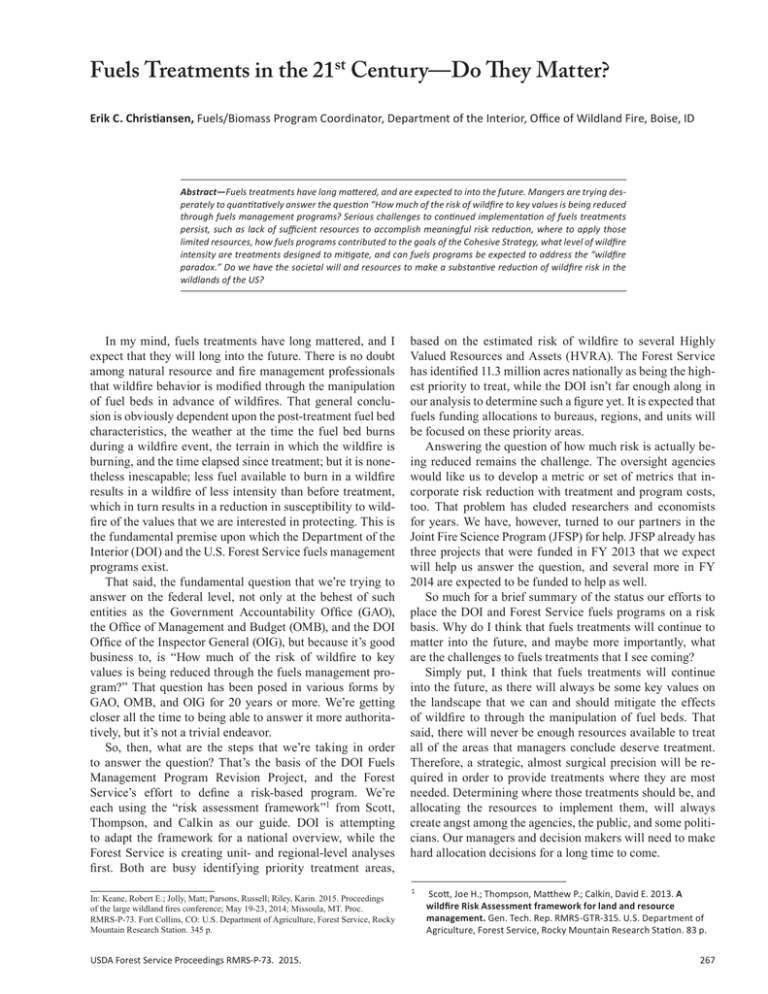
Fuels Treatments in the 21st Century—Do They Matter? Erik C. Christiansen, Fuels/Biomass Program Coordinator, Department of the Interior, Office of Wildland Fire, Boise, ID Abstract—Fuels treatments have long mattered, and are expected to into the future. Mangers are trying desperately to quantitatively answer the question “How much of the risk of wildfire to key values is being reduced through fuels management programs? Serious challenges to continued implementation of fuels treatments persist, such as lack of sufficient resources to accomplish meaningful risk reduction, where to apply those limited resources, how fuels programs contributed to the goals of the Cohesive Strategy, what level of wildfire intensity are treatments designed to mitigate, and can fuels programs be expected to address the “wildfire paradox.” Do we have the societal will and resources to make a substantive reduction of wildfire risk in the wildlands of the US? In my mind, fuels treatments have long mattered, and I expect that they will long into the future. There is no doubt among natural resource and fire management professionals that wildfire behavior is modified through the manipulation of fuel beds in advance of wildfires. That general conclusion is obviously dependent upon the post-treatment fuel bed characteristics, the weather at the time the fuel bed burns during a wildfire event, the terrain in which the wildfire is burning, and the time elapsed since treatment; but it is nonetheless inescapable; less fuel available to burn in a wildfire results in a wildfire of less intensity than before treatment, which in turn results in a reduction in susceptibility to wildfire of the values that we are interested in protecting. This is the fundamental premise upon which the Department of the Interior (DOI) and the U.S. Forest Service fuels management programs exist. That said, the fundamental question that we’re trying to answer on the federal level, not only at the behest of such entities as the Government Accountability Office (GAO), the Office of Management and Budget (OMB), and the DOI Office of the Inspector General (OIG), but because it’s good business to, is “How much of the risk of wildfire to key values is being reduced through the fuels management program?” That question has been posed in various forms by GAO, OMB, and OIG for 20 years or more. We’re getting closer all the time to being able to answer it more authoritatively, but it’s not a trivial endeavor. So, then, what are the steps that we’re taking in order to answer the question? That’s the basis of the DOI Fuels Management Program Revision Project, and the Forest Service’s effort to define a risk-based program. We’re each using the “risk assessment framework”1 from Scott, Thompson, and Calkin as our guide. DOI is attempting to adapt the framework for a national overview, while the Forest Service is creating unit- and regional-level analyses first. Both are busy identifying priority treatment areas, In: Keane, Robert E.; Jolly, Matt; Parsons, Russell; Riley, Karin. 2015. Proceedings of the large wildland fires conference; May 19-23, 2014; Missoula, MT. Proc. RMRS-P-73. Fort Collins, CO: U.S. Department of Agriculture, Forest Service, Rocky Mountain Research Station. 345 p. USDA Forest Service Proceedings RMRS-P-73. 2015. based on the estimated risk of wildfire to several Highly Valued Resources and Assets (HVRA). The Forest Service has identified 11.3 million acres nationally as being the highest priority to treat, while the DOI isn’t far enough along in our analysis to determine such a figure yet. It is expected that fuels funding allocations to bureaus, regions, and units will be focused on these priority areas. Answering the question of how much risk is actually being reduced remains the challenge. The oversight agencies would like us to develop a metric or set of metrics that incorporate risk reduction with treatment and program costs, too. That problem has eluded researchers and economists for years. We have, however, turned to our partners in the Joint Fire Science Program (JFSP) for help. JFSP already has three projects that were funded in FY 2013 that we expect will help us answer the question, and several more in FY 2014 are expected to be funded to help as well. So much for a brief summary of the status our efforts to place the DOI and Forest Service fuels programs on a risk basis. Why do I think that fuels treatments will continue to matter into the future, and maybe more importantly, what are the challenges to fuels treatments that I see coming? Simply put, I think that fuels treatments will continue into the future, as there will always be some key values on the landscape that we can and should mitigate the effects of wildfire to through the manipulation of fuel beds. That said, there will never be enough resources available to treat all of the areas that managers conclude deserve treatment. Therefore, a strategic, almost surgical precision will be required in order to provide treatments where they are most needed. Determining where those treatments should be, and allocating the resources to implement them, will always create angst among the agencies, the public, and some politicians. Our managers and decision makers will need to make hard allocation decisions for a long time to come. 1 Scott, Joe H.; Thompson, Matthew P.; Calkin, David E. 2013. A wildfire Risk Assessment framework for land and resource management. Gen. Tech. Rep. RMRS-GTR-315. U.S. Department of Agriculture, Forest Service, Rocky Mountain Research Station. 83 p. 267 The determination of where to place those treatments, is then, what I consider to be our biggest challenge, now and into the future. Ultimately, the decision makers will be faced with difficult choices, not the least of which will be the choice of maintaining an area already treated, where the wildfire risk is presumably at an acceptable level, versus treating an area of similar value, but where the wildfire risk exceeds some threshold. Since the advent of the National Fire Plan in 2001, the DOI and Forest Service have treated some 52.5 million acres to reduce or maintain fuel loadings. Depending on circumstances, many of those areas previously treated are due or overdue for re-treatment. Do we focus our efforts on maintaining these areas, depending upon the values they seek to protect, or do we seek to treat previously untreated areas? Additionally, how can we incorporate the other goals of the Cohesive Strategy? What, exactly, is the program’s contribution to restoring and maintaining the resilience of natural systems to wildfire; or in providing strategic opportunities to increase our capability to manage wildfire for resource benefits; or to increase public protection and firefighter safety? It will take time and effort to sort out those details, too. I think that another challenge managers face is determining what level or intensity of wildfire we try to plan our treatments to mitigate. Are we talking about a wildfire that we would expect to burn under “average” seasonal weather conditions? 95th percentile conditions? 100th? Then, how do changing conditions resulting from a changing climate affect where and how we intend to treat fuels? A fourth challenge is a persistent one, especially among the federal agencies, but not unknown to other jurisdictions and interested parties. It’s the wildfire paradox, as identified by Calkin2 and others, which maintains that using wildfire suppression to eliminate large and damaging wildfires ensures the inevitable occurrence of these fires. “Wildfire suppression, effective 95% to 98% of the time, inevitably leads to ecologically significant wildfires with higher intensities and rapid growth that are unable to be suppressed,” they write. How, given the significant alterations to most fuel beds as a result of about 150 years of organized fire suppression (I date the beginning of organized fire suppression, especially by the federal government, to 1872, when the US Army was assigned to manage Yellowstone NP), can a fuels program with significantly fewer resources than are available for wildfire suppression be expected to reduce wildfire risk in any but the most limited of manners? 2 Calkin, David E.; Cohen, Jack D.; Finney, Mark A.; Thompson, Matthew P. How risk management can prevent future wildfire disasters in the wildland-urban interface. In Proceedings of the National Academy of Sciences, pnas. 1315088111 268 The last challenge that I’ll mention is one that many fuels and fire managers see and lament regularly. I’ve personally seen it in places like the east slopes of the Cascades in Washington and Oregon, the Sierra foothills of California, and some locations in the southeast. I’m referring to the intolerance of the public and air quality regulators for short, two or three day smoke intrusions from prescribed fires. Many argue that they would rather take their chances that a wildfire will not directly impact them during fire season, and that they expect smoke for long periods anyway during the fire season. This attitude leads me to fear that our opportunities to use prescribed fire as a tool for fuels management are declining. So, as Dr. Reinhardt asks, what, indeed, have we accomplished? What do we hope to accomplish? What may be unrealistic for us to hope to accomplish? Is it reasonable to expect that the fuels program will help reduce suppression expenditures, as many today have suggested? Can the fuels management programs of DOI and the Forest Service meaningfully contribute to the goals of the Cohesive Strategy? Does it make sense to invest so heavily in preparedness and suppression, at the expense of fuels treatments, as so many speakers today have previously asked? Given the program challenges that we face, will the only fuels treatments of the future be the footprints of previous wildfires? In conclusion, we somehow need to discover how to, politically, organizationally, and professionally, move beyond simply placing treatments designed to mitigate risks to our highly valued resources and assets (HVRA), to placing treatments across landscapes so that the inevitable wildfires can be more safely managed, and to relieve the “wildfire paradox.” In many places across the nation, especially in the more arid western United States, wildfires are becoming possibly the most important vegetation management “tool” at our disposal. In order to use that tool as effectively as possible, more wildfires will need to be allowed to burn of their own accord, which will be of concern to many. This is possible only if fuels treatments are integrated or aligned with previously burned areas, so as to create compartments to allow for more passive or laissez faire management of wildfires. Otherwise, the “wildfire paradox” will surely continue. As my formal career in the field lasts only about another week, I won’t be the one to answer these questions. That I leave in your capable hands. I remain, however, confident that indeed, fuels treatments matter a great deal now, and will into the foreseeable future. The content of this paper reflects the views of the authors, who are responsible for the facts and accuracy of the information presented herein. USDA Forest Service Proceedings RMRS-P-73. 2015.
